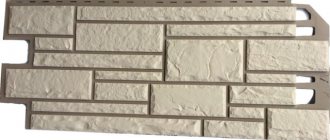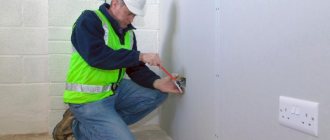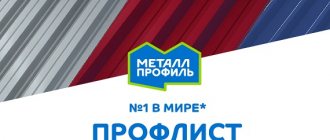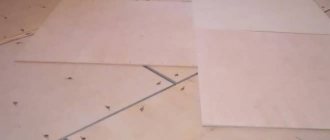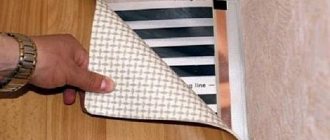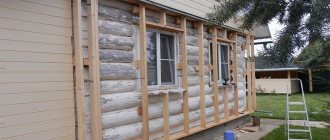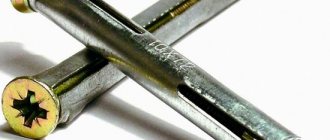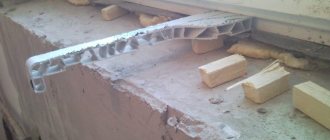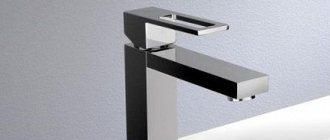A craftsman who wants to do the flooring in an apartment himself will have to make a difficult decision about choosing the material suitable for these purposes. Among the variety of options offered by the market, OSB flooring boards stand out.
Thanks to relatively inexpensive and fairly durable wood products, it is possible to obtain a reliable and durable coating. Anyone can lay an OSB floor on their own if they have certain skills.
Features of OSB
Oriented strand board is a kind of multi-layer cake, or rather a sandwich, usually consisting of three or more layers. Two of them (usually the upper and lower) are made based on a pressed structure of wood chips. A feature of the products is the order of laying chip elements, which are located along the workpiece in the outer layers and transversely in the inner layers.
It is for this reason that wood-based boards got their name (OSB in English means “oriented strand boards”). The specificity of the boards is that the particle structure is impregnated with reinforcing compounds such as wax, boric acid or special resins. Insulation pads in the form of plates made of expanded polystyrene or polyurethane foam are laid between their individual layers.
Cutting
Before installation, OSB is cut into sheets of different sizes. A hand or power tool can be used for this. When working, it is important to eliminate vibrations of the slab, so it is securely secured with clamps. To cut along a straight line, use guides made from straight boards. When sawing, it is important to use a corner so that the cut always goes perpendicular to the edge of the sheet.
When marking, you need to take into account the thickness of the cut; all tools have their own thickness. Before starting work, it is recommended to carry out a rough cutting of an unnecessary piece of material. Oriented strand material should be sawed at a moderate speed, the forward movement should be made smoothly. Marking is done using a ruler and a construction marker. Due to the large dimensions of the sheets, they are installed on a wooden stand; cutting in a vertical position is also possible. Let's look at the basic tools that can be used for cutting.
Some manufacturers produce blades specifically for cutting wood panels.
Choosing a floor slab
A competent approach to the selection of OSB boards laid on a wooden floor is impossible without taking into account such an important factor as the company that produces them. Preference is usually given to products from Europe and Latin America that have proven themselves in all respects (including strength indicators). To this should be added the need to assess the advantages and disadvantages of the slabs themselves.
Advantages and disadvantages
The undeniable advantages of unique products include:
- environmental friendliness of the material, the basis of which is natural wood;
- resistance to temperature changes and mechanical deformation;
- excellent indicators of strength and ductility of flooring manufactured on the basis of OSB;
- ease of processing and installation of the products themselves;
- uniformity of structure and attractive appearance;
- relatively low cost.
The list can be supplemented with a perfectly flat surface of OSB boards, on which, as on a subfloor, any finishing coatings (including linoleum) can be installed. The multi-layer structure guarantees good sound absorption, as well as additional insulation and waterproofing of the laid flooring.
Their relative disadvantage or disadvantage is the presence of phenolic components, which, according to the latest data, are completely absent in the latest environmentally friendly developments.
Required thickness
When choosing suitable slabs for flooring, it is important to take into account not only strength characteristics. To obtain a reliable and durable coating, their thickness should be taken into account, which is selected based on the following considerations:
- When laying OSB on a rough concrete base, slabs of 10 mm thickness are sufficient.
- When laying OSB on a wooden floor is intended, preference should be given to blanks with a thickness of 15 to 25 millimeters.
When carrying out rough work at various construction sites, the thickness of the OSB for the floor varies from 6 to 25 mm. Its specific value is selected depending on the following factors:
- brand of selected blanks;
- the magnitude of the expected load;
- the distance between the supporting logs (their pitch).
Only if all factors are observed will it be possible to achieve the required result, guaranteeing the reliability of the flooring structure.
What criteria are taken into account in comparison?
To determine which is better - plywood or OSB, they can be compared in terms of technical indicators. For example, let’s take two products 1 cm thick. The plywood will be made from coniferous veneer, and the OSB board will be class 3. Both of these options are relatively inexpensive, have a certain level of resistance to chemical attack and moisture, and are also environmentally friendly.
Oriented strand board OSB - 3 (OSP - 3)
Table. The relationship between the characteristics of plywood and OSB.
| Index | OSB | Plywood |
| Flexural strength along the longitudinal axis | 26 N/mm sq. | 47 N/mm sq. |
| Density | 610 kg/m3 | 550 kg/m3 |
| Chip resistance | 0.34 N/mm sq. | 1.2 N/mm sq. |
| Formaldehyde content | 7-8 mg/100g | 5-6 mg/100 g |
| Swelling in water during the day | 15% | 5% |
| Thermal conductivity | 0,13 | 0,12 |
Plywood walls and floor
Preparation of materials and tools
Those who decide to cover the floor with OSB boards with their own hands should first of all thoroughly prepare for the upcoming work. It will be necessary to stock up on a complete set of materials and tools, which should include:
- electric jigsaw and hammer drill;
- screwdriver;
- hammer;
- level and roulette.
You will need fastening elements (hardware), which include wood screws and special dowels. Before starting work, you should take care of the following materials:
- OSB boards themselves and skirting boards for them;
- insulation material (foam plastic, mineral wool);
- wooden logs;
- polyurethane foam and special adhesive mixture;
- varnish for treating the base for final coating.
Coloring compounds may be required, often used as decorative finishes.
Joint care
No matter how good and high-quality the sealant is, it also has its own service life. On average, protection lasts up to 15 years, but it can last even less - it all depends on the operating conditions.
Open and accessible seams should be periodically inspected and the condition of the sealant checked. Even sip panels should be removed from the vapor barrier layer once every 10 years and their condition checked. At the same time, the cracks will be examined and the protective membrane will be updated.
When conducting an audit, you should perform a number of simple steps:
With proper care of OSB joints, the boards will serve for a long time and reliably. Knowing their most vulnerable places, you can take targeted actions to protect them and significantly improve operating conditions and extend the service life of these wonderful materials.
OSB surfaces with sealed joints are a good basis for finishing. You can learn about various methods of finishing OSB and their features in separate articles:
OSB finishing indoors: walls, ceiling.
Source
Laying technology
Various rough coatings or structures can be used as the basis for installing OSB. Each type has its own styling features.
Dry screed
The possibility of arranging a floor without dampness and a long wait for the wet coating to dry forces homeowners to pay attention to dry screed. As such, fine expanded clay is often used, when leveling it it is customary to use unique beacons that allow you to indicate the level of installation.
OSB boards are laid on the prepared surface, pressed tightly into the expanded clay, after which a finishing coating is attached to them. This method can only be used in utility rooms (in the attic of a private house).
Concrete screed
In the case where it is intended to install OSB slabs on a concrete screed, it is recommended to adhere to the following sequence of actions:
- Special marks or beacons are installed that record the required filling level (the distance between them is selected based on the convenience of leveling the future coating, that is, approximately 50–60 cm).
- The correct installation of the marks is checked using a building level (if there are deviations, they should be leveled in the horizontal plane).
- You can proceed to preparing the solution, which must have the appropriate condition (not too thick and not very liquid).
- The prepared composition is poured into the place intended for forming the screed, after which it is carefully leveled.
The screed should set completely in about a day, after which it will be possible to start laying the floor. It will gain final strength only after 14–15 days (this depends on the air temperature in the room).
On the logs
When laying OSB on floors along joists in wooden houses, special attention is paid to such an important point as proper selection of the dimensions of the supporting structure. This applies to both the thickness of the bars themselves and the distance (step) chosen between them. Particular attention to the parameters is explained by the fact that OSB is a complex system, the further behavior of which cannot be predicted. The situation is aggravated in situations where it is planned to install a warm floor under the rough covering.
This is why it is so important to lay OSB correctly when supports in the form of logs are used for this. To comply with these requirements, the size of the bars is selected as follows:
- their cross-section should be 50 x 50 or 40 x 60 mm (depending on the thickness of the material);
- the distance between the support bars is selected starting from 40 cm;
- its exact value is determined by the dimensions of the products being laid.
Expert advice . With the above parameters, it is most convenient to use slab samples with a thickness of 15 to 17 mm.
If the flooring pitch is increased to 50 cm, the thickness of the OSB for the floor along the joists is chosen to be no less than 22 mm.
On a wooden floor
The so-called substrate for OSB on a wooden floor is an intermediate (rough) base, the use of which is considered the best option. Its presence will give the entire structure additional stability, and will also significantly reduce the load on the slab itself. The function of an auxiliary base can be performed by a coating of moisture-resistant plywood or an old floor.
Note! The old floor can be used only if the flooring is in good condition (if there are no clearly visible defects on it).
When preparing an old floor, you should scrape off any remaining paint, then thoroughly sand the surface and repair any scratches or cracks. Then they must be sanded and treated with a special protective compound (antiseptic). Only after completing all the preparatory procedures can you begin laying the slabs themselves.
Weaknesses of these products
Although the list of positive features of materials is impressive, there are also some disadvantages.
Weaknesses of plywood.
Plywood does not “like” water too much, so it cannot be used outdoors or in rooms where the humidity is quite high
OSB is made using various carcinogenic substances, which is harmful to the human body
To protect yourself from purchasing a product of poor quality, ask for certificates of quality and compliance. Each product has its own specifics, but they are almost the same in quality. So base your choice on your own preferences, budget and, of course, the location where you plan to install.
How to choose plywood
Based on the type of wood used for production, plywood can be divided into the following types:
Plywood is made from different types of wood, and each type differs in strength, resistance to moisture, weight
Plywood is considered to be made from the material that makes up the face of the veneer. Coniferous or combined products are mainly used in construction.
There are three-layer, five-layer and multi-layer plywood. All varieties of this product are classified based on the composition used for gluing.
FSF plywood is made using natural resins. Is wear resistant and durable
There are also these types of plywood:
FB veneer impregnated with bakelite varnish and glued with bakelite glue. Suitable for use in humid and even tropical environments, it does well in places where there is constant contact with water.
BS-veneer, impregnated and glued with bakelite glue, which is based on alcohol. This plywood is distinguished by unique quality characteristics: it is very durable, not afraid of noticeable mechanical impacts, and copes with an aggressive environment. Moderately flexible, does not allow water to pass through, and is not afraid of rotting. Previously, it was used only in aircraft and shipbuilding, so a simple buyer could not get this product.
BS-veneer plywood is often used, which has truly unique characteristics.
BS-veneer treated with bakelite glue, which is based on water. This product has the characteristics of BS, but its resistance to water is low, since the glue used for preparation dissolves in water.
In the process of repairing and finishing rooms, including floor treatment, the following types of plywood sheets are used: FK and FSF.
Plywood grade - the quality of the veneer layers located on the outside, the presence of knots, chips, and other damage. Regarding this characteristic, each plywood sheet can be divided into five types from E to IV in descending order of quality.
Which type of plywood is better to choose?
Visual component of plywood varieties
Please note: the grade is awarded separately to each of the two sides of the plywood sheet. In some cases, you can see the so-called plywood shop or conventional overcut, which has a torn edge. For this kind of product, a smaller sheet size is specified, taking into account the waste when cutting the edges, and then sent for sale.
According to surface treatment, plywood sheets can be:
For the final floor, single-sided or double-sided sanded plywood is used; you can use anything as a rough material. The smallest sheet thickness for laying on the floor is similar to OSB - 15 millimeters.
For the floor, it is better to use plywood sanded on both sides, which has a fairly large thickness - at least 15 mm
Advice! To achieve your goal, using a product with unnecessary consumer properties that are not relevant to you may be allowed, but this is not very logical from a budget perspective. It is better to purchase a product with a minimum of characteristics that suit you.
How to make a floor on an open balcony. DIY floor on an open balcony
Wood is a wonderful material. But it is in no way suitable for open spaces - it gets wet, dries out, molds and rots. What a difference it makes to street tiles! Wear-resistant, non-slip and not afraid of temperature changes.
If pre-screed has been done, laying tiles is a pleasure. If not, you'll have to tinker a little:
- The floor on the balcony should have a slight slope outward so that any water that gets in flows out freely and does not stagnate. Therefore, you cannot use special mixtures for screed - they are “self-leveling” and will simply flow to the lowest point, which will not allow making a slope.
- You can make the mixture for floor screed on the balcony yourself: for 40 kg of cement you need 3.5 buckets of sand, 10 buckets of limestone and a little more than 2 buckets of water.
- Beacons are installed - you can use metal profiles installed along the balcony (between short walls) at a distance of 50 cm from each other. Pieces of hardboard are placed under the ends to create the required slope and level the floor. You can also make beacons using self-tapping screws, as in the photo.
- First, the profiles are “poured” with solution in several places and again checked with a level. If necessary, their position is leveled.
- After a few hours, when the solution has set and the beacons will no longer move, you can make a screed.
To do this, a solution is poured between the beacons and the rule (longer than 60 cm) is leveled so that the profile ribs appear. Important: it is worth making formwork on the outside of the balcony so that the solution does not flow down onto the heads of passers-by. At the same time, if the fence of the loggia is a concrete slab, you need to leave a gap between the floor and the fence, otherwise the water will have nowhere to drain. - If the exit to the balcony is in the middle, fill first one half, starting from the far end, and then the second. The last thing to fill is the gap between the beacons opposite the door.
- If the thickness of the screed is small, you don’t have to water it and you can start laying tiles within a week. Otherwise, it is better to wait one two weeks to a month, watering the floor daily so that the concrete gains the necessary strength.
Comparison
Let's now compare the two products according to separate criteria to understand what is better to buy - OSB or plywood.
Water resistance
OSB board can handle short exposures to water. However, if you place it in a room with high humidity, it will become deformed.
Although it contains a lot of phenol-formaldehyde resin, it swells strongly and unevenly. Plywood behaves completely differently, more stable.
If we talk about resistance to moisture, then OSB-4 is worse in this regard compared to FC and FSF.
Properly treated plywood is quite resistant to moisture
Environmental friendliness
Product manufacturers are always looking for a compromise between water resistance and environmental friendliness, since an increase in one criterion often negatively affects the second.
Formaldehyde emissions from FSF and OSB plywood used for flooring are approximately the same and are within class E2. If we talk about the FC brand, this figure will be higher there, since resins are not used in production.
Plywood is considered a more environmentally friendly material
Fire resistance
Plywood burns excellently, but OSB does not support combustion. Of course, if a fire occurs, this will not affect the safety of housing in any way, but it may well affect the rate of spread of the fire.
OSB does not burn - and this is its great advantage
Sheet sizes and shape
The material is placed on the joists or directly on the base when it is level. The standard size of OSB is 1220x2440 millimeters, and it is specially tailored to the pitch between the lags. The best step size is 0.3 millimeters for subfloors and 0.4 or 0.
Plywood in the 1220x2440 format is not so popular; you can usually see sizes of 1525x1525 millimeters. Using this product, you will need to shorten the step or trim the sheet, and this forces you to spend additional money.
OSB has an excellent geometric shape, with diagonals everything is normal. Some of the slabs are made with a tongue-and-groove connection on two or four sides, due to which the joining is better.
It is easier to work with OSB, because this material has a size and shape more suitable for the floor
Ease of use
Both products in question can be cut with a hacksaw without any problems; nails are used for fastening. The weight of these materials is approximately equal. Sheets of plywood measuring 1525x1525 have an advantage over OSB when moving into a home.
Both materials are easy to saw, which is convenient when working with them
Visual component
For a floor that is not yet finalized, this point is not of significant importance, with the exception of grade IV plywood, which cannot be used for soft floor coverings.
For the final floor, it is advisable to take OSB, which has no problems with the surface, and the texture is much more pleasant, especially if the product is treated with paint or varnish.
OSB has a beautiful, smooth surface, so it is best used for finished floors
Strength comparison
Taken as a whole, plywood of the same thickness bends slightly less compared to OSB. For the formation of gender, this characteristic is very relevant. Strength is derived from an assessment of bending along and across the long side of the product.
Buckling strength:
If you compare materials of the same thickness, plywood bends less
Strength is also measured after the products are soaked. For OSB, the indicator is almost halved. As for plywood, it remains almost the same both when wet and after drying. Therefore, the choice of strength between plywood and OSB is obvious: plywood has higher strength. However, this information is relevant for FSF coniferous plywood - among other products, it best resists the effects of water, and it also has excellent strength data.
Comparison by weight
When you select suitable building materials, be sure to take into account such a criterion as mass. The feeling that a couple of extra pounds will not affect anything is deceptive. When carrying these very products, every extra gram is felt, not like a kilogram. Since the products we review may differ in size and thickness, it is more logical to compare based on density.
OSB is lighter than plywood, which is important when installing the material
In general, the density of sheet products is related to their thickness. The thinner the sheet, the higher the density, because it is necessary for the material to be durable. And they increase as density increases. Therefore, we will talk about average density. If you need specific data, it is better to go to the manufacturer’s website or study the characteristics in the store.
Average density:
Consequently, a cubic meter of plywood is slightly heavier than OSB. In general, we can say that the differences in mass are not too significant. So it is impossible to draw a conclusion as to which is better in terms of mass. The difference is minimal.
The differences in the weight of materials are not too significant, but OSB still “wins” according to this criterion
Cost and manufacturability of processing
If we touch on the price side of the issue, then OSB wins in terms of cost. This is quite logical: wood chips are cheaper than veneer. If we compare waterproof versions of domestically produced OSB and plywood, the cost of OSB is 50% lower, so the difference is noticeable. If compared with imported OSB, the price tag will be similar to plywood.
Questions regarding which is better of these two products are raised precisely because they have approximately the same scope of use and manufacturability. They are cut either with a hand saw for wood or with an electric jigsaw. You can use serious equipment, but the one already mentioned will be sufficient.
The price of OSB is lower than plywood
If we talk about the need for processing for the final coating, this is not required for OSB. There are plywood options that are already sanded and have a smooth surface. However, such plywood costs more, but OSB is always supplied smooth. Therefore, OSB wins here.
If you compare products by how they hold fasteners, you also cannot definitely decide which one is better. This criterion directly coincides with them. Although, to place screws in plywood, it is advisable to first drill holes to make your work easier. And self-tapping screws sink into OSB perfectly. It is only enough that the screwdriver has good torque.
Both plywood and OSB are easy to fix using self-tapping screws
Let's summarize the results of our comparison in a table
| Index | Plywood FC | Plywood FSF | OSB-3 | OSB-4 |
| Strength | Significantly higher than OSB | Significantly higher than OSB | Significantly lower than plywood and slightly lower than OSB-4 | Significantly lower than plywood and slightly higher than OSB-3 |
| Water resistance | Better than OSB, worse than FSF | Better than FC and OSB | Worse than plywood and OSB-4 | Worse than plywood, better than OSB-3 |
| Environmental friendliness | Higher than FSF and OSB | Lower than FC, approximately equal to OSB | Lower than FC, approximately equal to FSF | Lower than FC, approximately equal to FSF |
| Fire resistance | Much inferior to OSB | Much inferior to OSB | Significantly superior to plywood | Significantly superior to plywood |
| Sheet sizes, geometric shape | Inferior to OSB | Inferior to OSB | Better than plywood | Better than plywood |
| Ease of use | Approximately equal, sheets measuring 1525x1525 are easier to lift to a height | Approximately equal, sheets measuring 1525x1525 are easier to lift to a height | Approximately equal | Approximately equal |
| Can it be used for subfloors? | Yes, with the exception of grade IV (it is only for soft floors) | Yes, with the exception of grade IV (it is only for soft floors) | Yes | Yes |
| Can it be used for final flooring? | Yes, excluding grades III and IV, worse than OSB | Yes, excluding grades III and IV, worse than OSB | Yes, better than plywood | Yes, better than plywood |
| Price | Lower in comparison with FSF, one third higher in comparison with OSB | Higher in comparison with FC, one third higher in comparison with OSB | Lower in comparison with OSB-4, one third lower in comparison with plywood | Higher compared to OSB-3, lower by a third compared to plywood |
Assembly of the structure
The greatest number of difficulties arise when the subfloor made of OSB boards is assembled on joists. Here it is necessary to take into account all the above nuances. In addition to this, there are other recommendations:
- The components of the coating are fixed in such a way that cross-shaped joints and joints do not form. To do this, it is necessary to mount adjacent rows of sheets with an offset of about forty centimeters. You can make an offset by half the length of the sheet.
- A gap of 5–10 millimeters is needed between the wall and the edge of the sheet to compensate for temperature deformations of the coating.
- The elements themselves are not mounted closely, but with a minimum gap of three millimeters - this is necessary to avoid surface deformations.
- The upper side of the logs on which everything will be mounted is always leveled in one horizontal plane.
- The sheets must be fastened to the joists using self-tapping screws or nails with the heads recessed into the surface.
- If a particularly durable surface is needed, the sheets can be laid in two layers, perpendicular to each other.
The rest is not so difficult. It is only important to correctly maintain the level of the upper side of the bars and the distance between them. In this case, you can take sheets of smaller thickness - 8 or 10 millimeters. But it is important that the total thickness of the structure is not less than the thickness of a standard OSB sheet. Otherwise, there is no point in all the work - it is easier to assemble the subfloor on logs from OSB boards of standard thickness in one layer.



